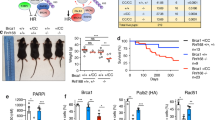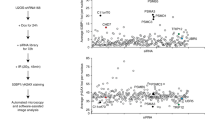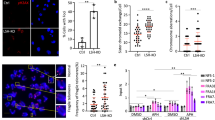Abstract
To detect and repair damaged DNA, DNA-damage-response proteins need to overcome the barrier of condensed chromatin to gain access to DNA lesions1. ATP-dependent chromatin remodelling is one of the fundamental mechanisms used by cells to relax chromatin in DNA repair2,3. However, the mechanism mediating their recruitment to DNA lesions remains largely unknown. BRIT1 (also known as MCPH1) is an early DNA-damage-response protein that is mutated in human primary microcephaly4,5,6,7,8. Here we report a previously unknown function of BRIT1 as a regulator of the ATP-dependent chromatin remodelling complex SWI–SNF in DNA repair. After damage to DNA, BRIT1 increases its interaction with SWI–SNF through ATM/ATR-dependent phosphorylation on the BAF170 subunit. This increase in binding affinity provides a means by which SWI–SNF can be specifically recruited to and maintained at DNA lesions. Loss of BRIT1 causes impaired chromatin relaxation as a result of decreased association of SWI–SNF with chromatin. This explains the decreased recruitment of repair proteins to DNA lesions and the reduced efficiency of repair in BRIT1-deficient cells, resulting in impaired cell survival after DNA damage. Our findings therefore identify BRIT1 as a key molecule that links chromatin remodelling with response to DNA damage in the control of DNA repair, and its dysfunction contributes to human disease.
This is a preview of subscription content, access via your institution
Access options
Subscribe to this journal
Receive 12 print issues and online access
$209.00 per year
only $17.42 per issue
Buy this article
- Purchase on Springer Link
- Instant access to full article PDF
Prices may be subject to local taxes which are calculated during checkout





Similar content being viewed by others
References
Tsukuda, T., Fleming, A. B. & Nickoloff, M. A. Chromatin remodeling at a DNA double-strand break site in Saccharomyces cerevisiae. Nature 438, 379–383 (2005).
Morrison, A. J. et al. IN80 and γ-H2AX interaction links ATP-dependent chromatin remodeling to DNA damage repair. Cell 119, 767–775 (2004).
van Attikum, H., Fritsch, O., Hohn, B. & Gasser, S. M. Recruitment of the INO80 complex by H2A phosphorylation links ATP-dependent chromatin remodeling with DNA double-strand break repair. Cell 119, 777–788 (2004).
Lin, S. Y. & Elledge, S. J. Multiple tumor suppressor pathways negatively regulate telomerase. Cell 113, 881–889 (2003).
Rai, R. et al. BRIT1 regulates early DNA damage response, chromosomal integrity, and cancer. Cancer Cell 10, 145–157 (2006).
Wood, J. L., Singh, N., Mer, G. & Chen, J. MCPH1 functions in an H2AX-dependent but MDC1-independent pathway in response to DNA damage. J. Biol. Chem. 282, 35416–35423 (2007).
Jackson, A. P. et al. Identification of microcephalin, a protein implicated in determining the size of the human brain. Am. J. Hum. Genet. 71, 136–142 (2002).
Alderton, G. K. et al. Regulation of mitotic entry by microcephalin and its overlap with ATR signalling. Nature Cell Biol. 8, 725–733 (2006).
Phelan, M. L., Sif, S., Narlikar, G. J. & Kingston, R. E. Reconstitution of a core chromatin remodeling complex from SWI/SNF subunits. Mol. Cell 3, 247–253 (1999).
Martens, J. A. & Winston, F. Recent advances in understanding chromatin remodeling by Swi/Snf complex. Curr. Opin. Genet. Dev. 13, 136–142 (2003).
Chen, J. & Archer, T. K. Regulating SWI/SNF subunit levels via protein–protein interactions and proteasomal degradation: BAF155 and BAF170 limit expression of BAF57. Mol. Cell. Biol. 25, 9016–9027 (2005).
Matsuoka, S. et al. ATM and ATR substrate analysis reveals extensive protein networks responsive to DNA damage. Science 316, 1160–1166 (2007).
Chai, B., Huang, J., Cairns, B. R. & Laurent, B. C. Distinct roles for the RSC and Swi/Snf ATP-dependent chromatin remodelers in DNA double-strand break repair. Genes Dev. 19, 1656–1661 (2005).
Park, J. H. et al. Mammalian SWI/SNF complexes facilitate DNA double-strand break repair by promoting γ-H2AX induction. EMBO J. 25, 3986–3997 (2006).
Sung, P. & Klein, H. Mechanism of homologous recombination: mediators and helicases take on regulatory functions. Nature Rev. Mol. Cell. Biol. 7, 739–750 (2006).
Lieber, M. R., Ma, Y., Pannicke, U. & Schwarz, K. Mechanism and regulation of human non-homologous DNA end-joining. Nature Rev. Mol. Cell Biol. 4, 712–720 (2003).
Pierce, A. J., Johnson, R. D., Thompson, L. H. & Jasin, M. XRCC3 promotes homology-directed repair of DNA damage in mammalian cells. Genes Dev. 13, 2633–2638 (1999).
Lin, S. Y., Rai, R., Li, K., Xu, Z. Y. & Elledge, S. J. BRIT1/MCPH1 is a DNA damage responsive protein that regulates the Brca1–Chk1 pathway, implicating checkpoint dysfunction in microcephaly. Proc. Natl Acad. Sci. USA 102, 15105–15109 (2005).
Scully, R. & Livingston, D. M. In search of the tumour-suppressor functions of BRCA1 and BRCA2. Nature 408, 429–432 (2000).
Xu, X., Lee, J. & Stern, D. F. Microcephalin is a DNA damage response protein involved in regulation of CHK1 and BRCA1. J. Biol. Chem. 279, 34091–34094 (2004).
Wood, J. L., Liang Y., Li, K. & Chen, J. Microcephalin/MCPH1 associates with the Condensin II complex to function in homologous recombination repair. J. Biol. Chem. 283, 29586–29592 (2008).
Nakanishi, K. et al. Human Fanconi anemia monoubiquitination pathway promotes homologous DNA repair. Proc. Natl Acad. Sci. USA 102, 1110–1115 (2005).
Ziv, Y. et al. Chromatin relaxation in response to DNA double-strand breaks is modulated by a novel ATM-and KAP-1 dependent pathway. Nature Cell Biol. 8, 870–876 (2006).
Boyer, L. A., Latek, R. R. & Peterson, C. L. The SANT domain: a unique histone-tail-binding module? Nature Rev. Mol. Cell. Biol. 5, 1–6 (2004).
Zou, L. & Elledge, S. J. Sensing DNA damage through ATRIP recognition of RPA–ssDNA complexes. Science 300, 1542–1548 (2003).
Sartori, A. A. et al. Human CtIP promotes DNA end resection. Nature 450, 509–514 (2007).
Narlikar, G. J., Fan, H. & Kingston, R. E. Cooperation between complexes that regulate chromatin structure and transcription. Cell 108, 475–487 (2002).
Peterson C. L. & Workman, J. L. Promoter targeting and chromatin remodeling by the SWI/SNF complex. Curr. Opin. Genet. Dev. 10, 187–192 (2000).
Goodarzi, A. A. et al. ATM signaling facilitates repair of DNA double-strand breaks associated with heterochromatin. Mol. Cell 31, 167–177 (2008).
Rass, U., Ahel, I. & West, S. C. Defective DNA repair and neurodegenerative disease. Cell 130, 991–1004 (2007).
Roberts, C. W. M & Orkin, S. H. The SWI/SNF complex: chromatin and cancer. Nature Rev. Cancer 4, 133–142 (2004).
Yu, X., Ghini, C. C., He, M., Mer, G. & Chen, J. The BRCT domain is a phospho-protein binding domain. Science 302, 639–642 (2003).
Pandita, T. K. et al. Ionizing radiation activates the ATM kinase throughout the cell cycle. Oncogene 19, 1386–1391 (2000).
Acknowledgements
We thank S. Rosenberg, X. Shen and F. Meric-Bernstam for critical reading of the manuscript; S. Deming for proofreading it; M. Jasin for reagents; E. Griffith for identifying the mutation in the MCPH no. 2 cell line; and the core facilities of the M. D. Anderson Cancer Center for mass spectrometry and fluorescence-activated cell sorting. This work was supported by a grant from the National Cancer Institute (R01CA112291) and an American Cancer Society Research Scholar Award to S.Y.L.
Author information
Authors and Affiliations
Contributions
S.-Y.L. conceived the project. G.P. and S.-Y.L. designed the experiments and wrote the manuscript. G.P. performed the experimental studies with technical assistance from H.D., E.-K.Y., M.-R.P. and R.H. on immunofluorescent staining, subcloning and western blotting. G.P. and K.L. performed data analysis. A.P.J. and I.v.d.B. contributed molecularly characterized cell lines from patients with MCPH1. A.P.J. also provided thoughtful comments on the manuscript.
Corresponding author
Ethics declarations
Competing interests
The authors declare no competing financial interests.
Supplementary information
Supplementary Information
Supplementary Information (PDF 2570 kb)
Rights and permissions
About this article
Cite this article
Peng, G., Yim, EK., Dai, H. et al. BRIT1/MCPH1 links chromatin remodelling to DNA damage response. Nat Cell Biol 11, 865–872 (2009). https://doi.org/10.1038/ncb1895
Received:
Accepted:
Published:
Issue Date:
DOI: https://doi.org/10.1038/ncb1895
This article is cited by
-
Aging-induced MCPH1 translocation activates necroptosis and impairs hematopoietic stem cell function
Nature Aging (2024)
-
Exploiting vulnerabilities of SWI/SNF chromatin remodelling complexes for cancer therapy
Oncogene (2021)
-
The N-terminal BRCT domain determines MCPH1 function in brain development and fertility
Cell Death & Disease (2021)
-
Dose-dependent hepatic toxicity and oxidative stress on exposure to nano and bulk selenium in mice
Environmental Science and Pollution Research (2021)
-
Multiple functions of SWI/SNF chromatin remodeling complex in plant-pathogen interactions
Stress Biology (2021)



